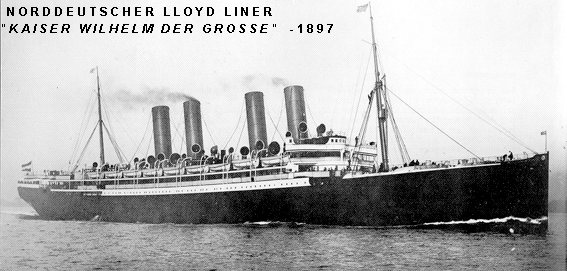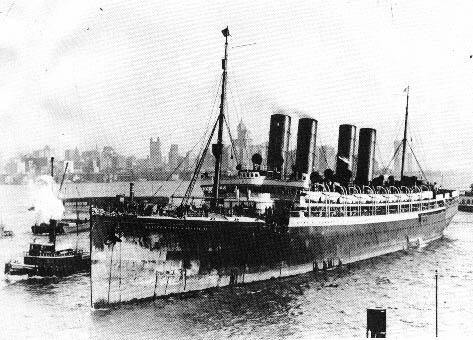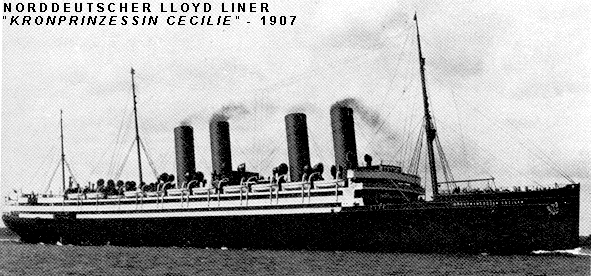Modern Germany in 1900
Nr. 005 - THE GERMAN STEAM LINERS AT THE BEGINNING OF THE 20th CENTURY
![]()
Modern Germany in 1900
Nr. 005 - THE GERMAN
STEAM LINERS AT THE BEGINNING OF THE 20th CENTURY
this article is a translation of
a webpage of M. Mike MAYER which may be read at the URL
http://www.concentric.net/~Mimayer/Liner.html
Mike MAYER gavez me the authorization to translate
in French his article and to insert it in my web page. Thanks to him. michel
b
He also allowed me to place his original article in the corresponding English
page of The UHLAN , keeping the site homogeneous.
Readers of the printed Uhlans may refer to the Nrs.6 and 7 dealing with the
later German steamers, the last built before the 1914 War, following those here
described : the Impérator and Vaterland,
bigger as Titanic as well as the shipyards in Hamburg.
Few people realize that the Germans had a siginificant share of the trans-Atlantic trade giving the British a good run for the money between 1897 and 1914 with some of the fastest and most fashionable ships on the Atlantic. They held the trans-Atlantic speed record, the legendary 'Blue Ribbon' from 1897 until 1907. They had the two largest ships in the world in 1913-1914 (Hamburg-Amerika's Imperator and Vaterland -see The Uhlan Nr.6 et Nr.7), until World War I intervened. Albert Ballin, the Managing Director of Hamburg-Amerika invented the Ala Carte ship-board restaurant in cooperation with Karl Ritz on Hotels, his ships interiors done by Charles Mewes, designer of the Ritz Hotel in Paris, as a whole design concept, rather than an eclectic collection of period designs. Mewes was the first to have the funnel uptakes divided to allow an unbroken central vista in the public rooms from one end of the ship to the other in the Vaterland of 1913. The First World War ended for good the German's important role on the Atlantic.
|
Steamship Line:
|
No. of Ships: | Tonnage: |
|---|---|---|
| Hamburg-Amerika Line |
194
|
1.307.411
|
| North German Lloyd |
135
|
907.996
|
| White Star Line |
33
|
472,877
|
| Cunard Line |
29
|
344,251
|
Taken from "Geschichte der Deutschen Passagierschiffahrt"
by Arnold Kludas This ranking includes ships under construction.

Norddeutscher Lloyd's Kaiser Wilhelm Der Grosse entered service in 1897. Named for Kaiser Wilhelm the Great - Wilhelm I, first emperor of a united Germany in 1871, she represented Germany's bid for a larger share of the trans-Atlantic trade dominated by Britain. She was, at the same time. the world's largest, fastest and the first of the modern, four-funneled ocean greyhounds that were to follow in her footsteps. 648 ft. long, 14,349 tons, twin-propellers, two four-cylinder, triple-expansion reciprocating (pistons and cranks three-decks high!) steam engines drove her at over 23 knots.
The Kaiser Wilhelm Der Grosse took the speed record from the British in 1897, and between her and Hamburg-America's Deutschland of 1900 (a virtual look-alike to the Kaiser) the Germans kept the trans-Atlantic speed record until the British launched a pair of four-funneled (of course), turbine-driven greyhounds, the famous Lusitania and the legendary Mauretania, (with funding from Parliment) that re-took the speed record, the Mauretania being slightly faster than the Lusitania, in 1907.
The gallant old Mauretania kept the speed record unitl 1929, when the Germans built a pair of modern super-liners using the then-radical 'bulbous bow' hull design, re-took it. The old Mauretania attempted to keep the record and the crew was authorized by the Cunard Line to make the attempt and bested her own time, but was unable to out-perform the modern Bremen and Europa. However, throughout the 1920's the ageing Mauretania retained the affections of her loyal clientel, inspite of her lack of modern amenities and private baths and even after she lost the speed record in 1929. She was known as the "Rostron Express" for her exceptional on-time performance.The affectionate nickname was coined due to her long-time captain Arthur Rostron, who, it was said, never missed his train to London because Mauretania was so reliable.
 |
| The Kaiser Willhelm Der Grosse arriving New York (Hoboken N.J.) after a typical fast run. The paint in those days could not stand the pounding of the Atlantic waves on a fast steamer. Paint stripped in this manner indicated a record-breaker |
Such was the reputation established by the Kaiser and her three running-mates: Kronprinz Wilhelm - 1901, and the larger Kaiser Wilhelm II - 1903 (known as 'Rolling Billy' to her loyal clientel) and her sister, the famous Kronprinzessin Cecilie - 1906 that 'four funnels' became an important marketing tool - synonymous with safety, speed and reliability - so much so that White Star Line's Olympic and Titanic's fourth funnel was a dummy - just for appearances and as an engine room vent.
Until 1907 and the advent of Lusitania and Mauretania, which were over 790 feet long and 31,938 tons, the Germans with the Nord Deutscher Lloyd and Hamburg-America Line had the fastest and most famous ships on the North Atlantic. Until World War I, the German's had a large share of the Atlantic market. Under the creative guidance of Albert Ballin, Hamburg-America Line specialized in large, luxurious ships with superb service. Herr Ballin traveled often and always had an eye for improvements and innovation. One of three Hamburg-America super liners larger than the Titanic and Olympic were already being built when the Titanic embarked on her fatal maiden voyage. But the First World War ended the German's bid for the cream of the trans-Atlantic trade.
The Kaiser Wilhelm Der Grosse and her sister Kronprinz Wilhelm were converted into Armed Merchant Cruisers in 1914 by installing naval guns and stores. The Kaiser and the Kronprinz's captains were always chivalrous and allowed the crews to escape before turning their guns on the intended victim and even carrying the crews and passengers of their prey to neutral ports. (n'oublions pas qu'en 1915 le torpillage du Lusitania par un sous-marin allemand a bel et bien été salué comme un exploit ! )
The Kaiser was cornered off the coast of Africa by a British cruiser and was sunk in a gun battle. The Kronprinz Wilhelm, after a 251-day cruise and having sunk many tons of allied shipping was in bad shape. Leaking, the crew sick with beri-beri and almost out of supplies, she made a run for Norfolk, Virginia in the still-neutral U.S. on night of April 10, 1915. The engineers coaxed the maximum revolutions from the worn out old reciprocating engines and according to some accounts, the engines were practically leaping off their bed-plates and shaking the ship so much that the crew had to hold on to remain standing. The worn-out old Kronprinz sailed like an express train right under the nose of patrolling British cruisers into the U.S. territorial waters and safety. Refitted when the U.S. entered the War, she was renaimed the Von Steuben, after the Prussian General who drilled the armies of the American Revolution, and served as a troopship.
 The
Kronprinzessin Cecilie (Crown Princess Cecilie),
a virtual sister to the Kaiser Wilhelm II, was the largest of the four NDL ships:
19,360 tons, 707 feet long, steam quadruple-expansion reciprocating engines,
twin propellers drove her at over 23 knots, as fast as her sisters.
The
Kronprinzessin Cecilie (Crown Princess Cecilie),
a virtual sister to the Kaiser Wilhelm II, was the largest of the four NDL ships:
19,360 tons, 707 feet long, steam quadruple-expansion reciprocating engines,
twin propellers drove her at over 23 knots, as fast as her sisters.
Kronprinzessin Cecilie's moment of fame was in August, 1914, when she was en-route to Germany, half-way across when war was declared. She was carrying millions in gold bullion. Captain Pollack turned around in mid-ocean and headed back to the U.S. rather than face certain capture by the British if he attempted to run for home. Despite protests by passengers and an offer to buy the ship by some American millionaires on board so they could legitimately fly the U.S. flag, Captain Pollack headed for the neutral United States. Volunteer crew members, choking on soot and stack gasses, painted the tops of the yellow funnels black in an effort to disguise the ship as White Star's Olympic. The distinctive paired funnels would not fool the navy but might fool a passing merchant ship. The Kronprinzessin had vanished and newpaper headlines wondered about the whereabouts of the 'Kaiser's Treasure Ship.' In consultation with an American banker and yachtsman C. Ledyard Blair, Captain Pollack decided to put into the summer resort of Bar Harbor, Maine as a safer alternative than to risk further interception by British naval units. During the early morning hours of August 4, Blair joined Captain Pollack on the bridge and assisted in piloting the Kronprizessin into Bar Harbor. Residents awoke to find the 'Olympic' moored in Bar Harbor. The ship's real identity was quickly ascertained and the mystery of her dissapearance was resolved. After a week or so (and quite a holiday for the German crew) she was escorted to Boston where she and her crew were interned.
When the U.S. entered the war, she and her sisters were taken over and served as troopships. The Kronprinzessin was re-named Mt. Vernon and while loaded with American wounded returning home in September, 1918, she was torpedoed in the rear boiler room, killing 37. Her magnificent watertight subdivision kept her afloat and she steamed back to France under her own power, making 15 knots! After the war, the Kronprinz, the Kaiser Wilhelm II and Kronprizessin Cecilie sat and rusted for years and were eventually scrapped, a sad end for so proud a fleet..
To visit Mike Mayer's site click here Mimayer Home page